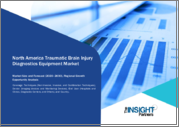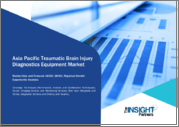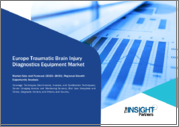
|
시장보고서
상품코드
1771617
미국의 외상성 뇌손상 바이오마커 시장 규모, 점유율, 동향 분석 보고서 : 유형별, 샘플 유형별, 용도별, 최종 용도별, 부문 예측(2025-2033년)U.S. Traumatic Brain Injury Biomarkers Market Size, Share & Trends Analysis Report By Type (Protein Biomarkers, Genetic Biomarkers, Metabolomic Biomarkers), By Sample Type, By Application, By End Use, And Segment Forecasts, 2025 - 2033 |
||||||
시장 규모와 동향 :
미국의 외상성 뇌손상 바이오마커 시장 규모는 2024년에 4억 960만 달러에 달했고 2033년에는 18억 5,473만 달러에 이를 것으로 예측되고, 2025년부터 2033년까지의 CAGR은 18.8%를 나타낼 것으로 전망됩니다.
미국의 외상성 뇌손상 바이오마커 시장은 소아 외상성 뇌손상(TBI) 진단에 대한 수요 증가, 뇌 손상에 대한 인식과 자금 증가, 학술기관과 산업계의 협력관계 가속 등에 의해 크게 확대되고 있습니다.
TBI는 머리에 대한 의도파관 않은 충격을 의미하며 경미한 장애에서 심각한 신경학적 손상 또는 죽음으로 이어질 수 있습니다. 미국의 뇌손상협회 보고서(2025년)에 따르면 미국에서는 의식 상실을 동반한 외상성 뇌손상을 경험한 40세 이상의 약 1,140만명이 현재 장애를 가지고 생활하고 있다고 보고되고 있습니다. 또한 매년 약 290만명의 TBI 관련 구급 외래 진찰이 보고되고 있으며, 뇌 손상에 따른 건강 관리 부담이 큰 것으로 나타났습니다.
어린이나 청소년은 전도, 스포츠 외상, 사고 등에 의한 TBI의 영향을 특히 받기 쉽습니다. 미국에서는 매년 소아의 TBI에 의해 추정 50만건의 구급 외래를 진찰하고 있습니다. 이 장기적인 영향은 성인보다 소아 쪽이 현저하게 크고, 소아 TBI가 공중 보건과 생활의 질에 미치는 심각하고 영구적인 부담이 큽니다.
혈액 기반의 바이오마커는 청소년 환자의 상해 위험과 중증도를 평가하는 비침습적이고 객관적인 방법을 제공합니다. ABCDx, 제네바 대학교, 발 데브론 병원이 참여한 이 다기관 연구는 두개 내 손상(ICI)이 있는 어린이와 그렇지 않은 어린이를 정확하게 구분하는 혈액 바이오마커의 잠재력을 강조했습니다.
연구대학, 바이오테크놀러지 기업, 의료 제공자 간의 강력한 연계에 의해 바이오마커의 검증이나 상업화가 진행되고 있습니다. 이와 관련하여 새로운 임상시험은 TBI의 진단과 치료를 전진시키는 큰 가능성을 지니고 있습니다. 급성과 장기 TBI 관리에서 환자의 결과를 변경할 수 있습니다. 공유는 바이오마커의 신뢰성을 높이는 종단적 연구를 지원합니다.
의학적, 사회적, 제도적 요인의 융합은 미국 시장에서 TBI 바이오마커에 대한 자금 제공 증가를 뒷받침하고 있습니다. 기존의 화상 진단에서는 경미하거나 조기의 상해를 검출할 수 없는 경우가 많아, 객관적이고 신속하고 비침습적인 평가를 제공하는 바이오마커 기반의 솔루션의 필요성이 높아지고 있습니다. 연구 프로그램(CDMRP) 및 미국 육군 의료 연구 개발 사령부(USAMRDC)와 같은 정부 기관은 외상성 뇌 손상 및 심리적 건강 연구 프로그램(TBIPHRP)과 같은 노력에 대한 투자를 늘리고 있습니다. TBI의 심리적 영향에도 대처하는 것을 목적으로 하고 있습니다.
목차
제1장 조사 방법과 범위
제2장 주요 요약
제3장 미국의 외상성 뇌손상 바이오마커 시장 변수, 동향, 범위
- 시장 계통 전망
- 상위 시장 전망
- 관련/보조 시장 전망
- 시장 역학
- 시장 성장 촉진요인 분석
- 시장 성장 억제요인 분석
- 미국의 외상성 뇌손상 바이오마커 시장 분석 툴
- 업계 분석 - Porter's Five Forces 분석
- PESTEL 분석
제4장 미국의 외상성 뇌손상 바이오마커 시장 : 유형 추정·동향 분석
- 유형별 시장 점유율(2024년 및 2033년)
- 부문 대시보드
- 미국의 외상성 뇌손상 바이오마커 시장 : 유형 변동 분석
- 미국의 외상성 뇌손상 바이오마커 시장 규모와 동향 분석(유형별, 2021-2033년)
- 미국의 외상성 뇌손상 바이오마커 시장 수익 추계와 예측(2021-2033년)
- 단백질 바이오마커
- 유전자 바이오마커
- 대사체 바이오마커
제5장 미국의 외상성 뇌손상 바이오마커 시장 : 샘플 유형 추정·동향 분석
- 샘플 유형 시장 점유율(2024년 및 2033년)
- 부문 대시보드
- 미국의 외상성 뇌손상 바이오마커 시장 : 샘플 유형별 전망
- 시장 규모와 예측 및 동향 분석(2021-2033년)
- 혈액 기반
- 뇌척수액(CSF) 기반
- 소변 기반
제6장 미국의 외상성 뇌손상 바이오마커 시장 : 용도 추정·동향 분석
- 용도 시장 점유율(2024년 및 2033년)
- 부문 대시보드
- 미국의 외상성 뇌손상 바이오마커 시장 : 용도별 전망
- 시장 규모와 예측 및 동향 분석(2021-2033년)
- 진단
- 예후
- 치료 반응 모니터링
제7장 미국의 외상성 뇌손상 바이오마커 시장 : 최종 용도 추정·동향 분석
- 최종 용도 시장 점유율(2024년 및 2033년)
- 부문 대시보드
- 미국의 외상성 뇌손상 바이오마커 시장 : 최종 용도별 전망
- 시장 규모와 예측 및 동향 분석(2021-2033년)
- 병원 및 진료소
- 진단실험실
- 연구기관
제8장 미국의 외상성 뇌손상 바이오마커 시장 : 국가별 추정·동향 분석
- 국가별 시장 점유율 분석(2024년 및 2033년)
- 국가별 시장 대시보드
- 미국 시장 현황
- 시장 규모, 예측 동향 분석(2021-2033년)
- 미국
- 주요국의 동향
- 규제 틀/상환
- 경쟁 시나리오
제9장 경쟁 구도
- 주요 시장 진출기업에 의한 최근의 동향과 영향 분석
- 기업/경쟁의 분류
- 벤더 상황
- 주요 리셀러 및 채널 파트너 목록
- Key customers
- Key company market share analysis, 2024
- Quanterix.
- Banyan Biomarkers, Inc.
- Abbott
- GE Healthcare.
- Thermo Fisher Scientific Inc.
- Immunarray.
- Oculogica
- NeuroTrauma Sciences, LLC
- BRAINBox Solutions, Inc.
- Myriad Genetics, Inc.
- Abcam Limited
Market Size & Trends:
The U.S. traumatic brain injury biomarkers market size was estimated at USD 409.60 million in 2024, is projected to reach 1,854.73 million by 2033, and is forecasted to grow at a CAGR of 18.8% from 2025 to 2033. The U.S. traumatic brain injury (TBI) biomarkers market is expanding significantly due to increasing demand for pediatric TBI diagnosis, growing awareness and funding related to brain injury, and accelerating collaboration between academic institutions and industry.
TBI refers to an unintentional impact to the head that can lead to outcomes ranging from mild impairment to severe neurological damage or even death. According to a report by the Brain Injury Association America, 2025, the U.S. reported approximately 11.4 million individuals over the age of 40 who experienced a traumatic brain injury (TBI) resulting in loss of consciousness are currently living with a disability. In addition, around 2.9 million TBI-related emergency department visits are reported each year, indicating the significant healthcare burden associated with brain injuries.
Children and adolescents are particularly vulnerable to TBIs from falls, sports injuries, and accidents, yet symptoms can be subtle or delayed. Every year in the U.S., pediatric TBI leads to an estimated 500,000 emergency department visits. While children have a lower overall mortality rate, accounting for about 5% of all TBI-related deaths, the broader impact is more evident when considering years of life lost and years lived with disability. These long-term effects are notably greater in children than in adults, with the serious and lasting burden pediatric TBI poses on public health and quality of life. Pediatric care providers are increasingly turning to biomarker diagnostics to make safer and faster decisions, especially to reduce unnecessary radiation exposure from CT scans.
Blood-based biomarkers offer a non-invasive, objective method to assess injury risk and severity in young patients. A collaborative study conducted in June 2024, by renowned hospitals in Switzerland and Spain, discovered potential blood biomarkers that could significantly improve the diagnosis and management of mild traumatic brain injury (mTBI) in children. This multi-center research, involving ABCDx, the University of Geneva, and Vall d'Hebron Hospital, highlighted the potential of these blood biomarkers to accurately differentiate children with intracranial injuries (ICI) from those without. This reduced unnecessary CT scans and shorter hospital observation periods, improving efficiency in pediatric mTBI care.
Strong collaboration between research universities, biotech companies, and healthcare providers is advancing biomarker validation and commercialization. Institutions are working with biotech and diagnostics companies to translate laboratory discoveries into clinical tests. A new clinical trial holds significant promise for advancing the diagnosis and treatment of TBI. Focused on evaluating innovative diagnostic tools or therapeutic approaches, this trial could pave the way for more effective and timely interventions, potentially transforming patient outcomes in acute and long-term TBI management. These partnerships help accelerate clinical trials, FDA submissions, and market entry. In addition, shared data resources and biobanks support longitudinal studies that strengthen biomarker credibility. The U.S. ecosystem's ability to foster innovation through public-private-academic collaboration is a major competitive advantage in expanding the TBI biomarker market.
A convergence of medical, social, and institutional factors drives rising funding for TBI biomarkers in the U.S. market. Growing public awareness of TBIs' long-term consequences, particularly in sports and military populations, has amplified demand for more accurate and timely diagnostic tools. Traditional imaging often falls short in detecting mild or early-stage injuries, creating a critical need for biomarker-based solutions to provide objective, rapid, and non-invasive assessments. In February 2024, government agencies such as the Congressionally Directed Medical Research Programs (CDMRP) and the U.S. Army Medical Research and Development Command (USAMRDC) have increased investments in initiatives like the Traumatic Brain Injury and Psychological Health Research Program (TBIPHRP). These efforts aim to advance early detection, treatment, and prevention strategies, while also addressing the psychological effects of TBI. Coupled with growing commercialization potential and venture capital interest, this influx of funding is accelerating innovation and reshaping the TBI biomarker landscape in the United States.
U.S. Traumatic Brain Injury Biomarkers Market Report Segmentation
This report forecasts revenue growth at country levels and provides an analysis of the latest industry trends in each of the sub-segments from 2021 to 2033. For this study, Grand View Research has segmented U.S. traumatic brain injury biomarkers market report based on type, sample type, application, and end use:
- Type Outlook (Revenue, USD Million, 2021 - 2033)
- Protein Biomarkers
- Genetic Biomarkers
- Metabolomic Biomarkers
- Sample Type Outlook (Revenue, USD Million, 2021 - 2033)
- Blood-based
- Cerebrospinal fluid (CSF)-based
- Urine-based
- Application Outlook (Revenue, USD Million, 2021 - 2033)
- Diagnosis
- Prognosis
- Monitoring treatment response
- End Use Outlook (Revenue, USD Million, 2021 - 2033)
- Hospitals & Clinics
- Diagnostic Laboratories
- Research Institutes
Table of Contents
Chapter 1. Methodology and Scope
- 1.1. Market Segmentation & Scope
- 1.2. Segment Definitions
- 1.2.1. Type
- 1.2.2. Sample Type
- 1.2.3. Application
- 1.2.4. End user
- 1.2.5. Country scope
- 1.2.6. Estimates and forecasts timeline.
- 1.3. Research Methodology
- 1.4. Information Procurement
- 1.4.1. Purchased database
- 1.4.2. GVR's internal database
- 1.4.3. Secondary sources
- 1.4.4. Primary research
- 1.4.5. Details of primary research
- 1.5. Information or Data Analysis
- 1.5.1. Data analysis models
- 1.6. Market Formulation & Validation
- 1.7. Model Details
- 1.7.1. Commodity flow analysis (Model 1)
- 1.7.2. Approach 1: Commodity flow approach
- 1.7.3. Volume price analysis (Model 2)
- 1.7.4. Approach 2: Volume price analysis
- 1.8. List of Secondary Sources
- 1.9. List of Primary Sources
- 1.10. Objectives
Chapter 2. Executive Summary
- 2.1. Market Outlook
- 2.2. Segment Outlook
- 2.2.1. Type outlook
- 2.2.2. Sample type outlook
- 2.2.3. Application outlook
- 2.2.4. End use outlook
- 2.2.5. Country outlook
- 2.3. Competitive Insights
Chapter 3. U.S. Traumatic Brain Injury Biomarkers Market Variables, Trends & Scope
- 3.1. Market Lineage Outlook
- 3.1.1. Parent market outlook
- 3.1.2. Related/ancillary market outlook.
- 3.2. Market Dynamics
- 3.2.1. Market driver analysis
- 3.2.2. Market restraint analysis
- 3.3. U.S. Traumatic Brain Injury Biomarkers Market Analysis Tools
- 3.3.1. Industry Analysis - Porter's
- 3.3.2. PESTEL Analysis
Chapter 4. U.S. Traumatic Brain Injury Biomarkers Market: Type Estimates & Trend Analysis
- 4.1. Type Market Share, 2024 & 2033
- 4.2. Segment Dashboard
- 4.3. U.S. Traumatic Brain Injury Biomarkers Market: Type Movement Analysis
- 4.4. U.S. Traumatic Brain Injury Biomarkers Market Size & Trend Analysis, by type, 2021 to 2033 (USD Million)
- 4.5. U.S. Traumatic Brain Injury Biomarkers Market Revenue Estimates and Forecasts, 2021 - 2033 (USD Million)
- 4.6. Protein biomarkers
- 4.6.1. Protein biomarkers Market estimates and forecasts, 2021 - 2033 (USD Million)
- 4.7. Genetic biomarkers
- 4.7.1. Genetic biomarkers Market estimates and forecasts, 2021 - 2033 (USD Million)
- 4.8. Metabolomic biomarkers
- 4.8.1. Metabolomic biomarkers Market estimates and forecasts, 2021 - 2033 (USD Million)
Chapter 5. U.S. Traumatic Brain Injury Biomarkers Market: Sample type Estimates & Trend Analysis
- 5.1. Sample type Market Share, 2024 & 2033
- 5.2. Segment Dashboard
- 5.3. U.S. Traumatic Brain Injury Biomarkers Market by Sample type Outlook
- 5.4. Market Size & Forecasts and Trend Analyses, 2021 to 2033 for the following
- 5.5. Blood-based
- 5.5.1. Blood-based Market estimates and forecasts, 2021 - 2033 (USD Million)
- 5.6. Cerebrospinal fluid (CSF)-based
- 5.6.1. Cerebrospinal fluid (CSF)-based Market estimates and forecasts, 2021 - 2033 (USD Million)
- 5.7. Urine-based
- 5.7.1. Urine-based Market estimates and forecasts, 2021 - 2033 (USD Million)
Chapter 6. U.S. Traumatic Brain Injury Biomarkers Market: Application Estimates & Trend Analysis
- 6.1. Application Market Share, 2024 & 2033
- 6.2. Segment Dashboard
- 6.3. U.S. Traumatic Brain Injury Biomarkers Market by Application Outlook
- 6.4. Market Size & Forecasts and Trend Analyses, 2021 to 2033 for the following
- 6.5. Diagnosis
- 6.5.1. Diagnosis Market estimates and forecasts, 2021 - 2033 (USD Million)
- 6.6. Prognosis
- 6.6.1. Prognosis Market estimates and forecasts, 2021 - 2033 (USD Million)
- 6.7. Monitoring treatment response
- 6.7.1. Monitoring treatment response, Market estimates and forecasts, 2021 - 2033 (USD Million)
Chapter 7. U.S. Traumatic Brain Injury Biomarkers Market: End use Estimates & Trend Analysis
- 7.1. End Use Market Share, 2024 & 2033
- 7.2. Segment Dashboard
- 7.3. U.S. Traumatic Brain Injury Biomarkers Market by End use Outlook
- 7.4. Market Size & Forecasts and Trend Analyses, 2021 to 2033 for the following
- 7.5. Hospitals & Clinics
- 7.5.1. Hospitals & Clinics Market estimates and forecasts, 2021 - 2033 (USD Million)
- 7.6. Diagnostic Laboratories
- 7.6.1. Diagnostic Laboratories Market estimates and forecasts, 2021 - 2033 (USD Million)
- 7.7. Research Institutes
- 7.7.1. Research Institutes Market estimates and forecasts, 2021 - 2033 (USD Million)
Chapter 8. U.S. Traumatic Brain Injury Biomarkers Market: Country Estimates & Trend Analysis
- 8.1. Country Market Share Analysis, 2024 & 2033
- 8.2. Country Market Dashboard
- 8.3. U.S. Country Market Snapshot
- 8.4. Market Size, & Forecasts Trend Analysis, 2021 to 2033:
- 8.5. U.S.
- 8.5.1. Key country dynamics
- 8.5.2. Regulatory framework/Reimbursement
- 8.5.3. Competitive scenario
- 8.5.4. U.S. market estimates and forecasts, 2021 - 2033 (USD Million)
Chapter 9. Competitive Landscape
- 9.1. Recent Developments & Impact Analysis, By Key Market Participants
- 9.2. Company/Competition Categorization
- 9.3. Vendor Landscape
- 9.3.1. List of key distributors and channel partners
- 9.3.2. Key customers
- 9.3.3. Key company market share analysis, 2024
- 9.3.4. Quanterix.
- 9.3.4.1. Company overview
- 9.3.4.2. Financial performance
- 9.3.4.3. Services benchmarking
- 9.3.4.4. Strategic initiatives
- 9.3.5. Banyan Biomarkers, Inc.
- 9.3.5.1. Company overview
- 9.3.5.2. Financial performance
- 9.3.5.3. Services benchmarking
- 9.3.5.4. Strategic initiatives
- 9.3.6. Abbott
- 9.3.6.1. Company overview
- 9.3.6.2. Financial performance
- 9.3.6.3. Services benchmarking
- 9.3.6.4. Strategic initiatives
- 9.3.7. GE Healthcare.
- 9.3.7.1. Company overview
- 9.3.7.2. Financial performance
- 9.3.7.3. Services benchmarking
- 9.3.7.4. Strategic initiatives
- 9.3.8. Thermo Fisher Scientific Inc.
- 9.3.8.1. Company overview
- 9.3.8.2. Financial performance
- 9.3.8.3. Services benchmarking
- 9.3.8.4. Strategic initiatives
- 9.3.9. Immunarray.
- 9.3.9.1. Company overview
- 9.3.9.2. Financial performance
- 9.3.9.3. Services benchmarking
- 9.3.9.4. Strategic initiatives
- 9.3.10. Oculogica
- 9.3.10.1. Company overview
- 9.3.10.2. Financial performance
- 9.3.10.3. Services benchmarking
- 9.3.10.4. Strategic initiatives
- 9.3.11. NeuroTrauma Sciences, LLC
- 9.3.11.1. Company overview
- 9.3.11.2. Financial performance
- 9.3.11.3. Services benchmarking
- 9.3.11.4. Strategic initiatives
- 9.3.12. BRAINBox Solutions, Inc.
- 9.3.12.1. Company overview
- 9.3.12.2. Financial performance
- 9.3.12.3. Services benchmarking
- 9.3.12.4. Strategic initiatives
- 9.3.13. Myriad Genetics, Inc.
- 9.3.13.1. Company overview
- 9.3.13.2. Financial performance
- 9.3.13.3. Services benchmarking
- 9.3.13.4. Strategic initiatives
- 9.3.14. Abcam Limited
- 9.3.14.1. Company overview
- 9.3.14.2. Financial performance
- 9.3.14.3. Services benchmarking
- 9.3.14.4. Strategic initiatives
(주말 및 공휴일 제외)


















